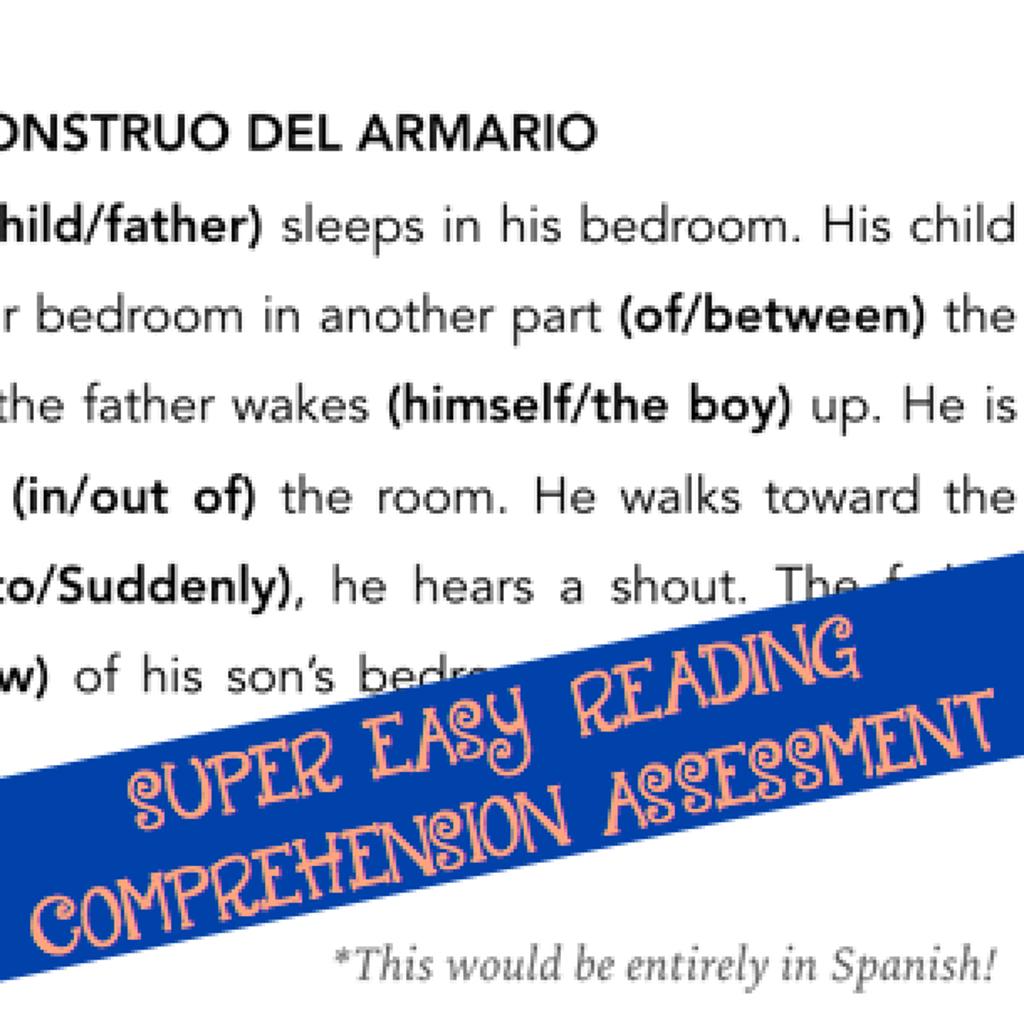A binary CLOZE reading comprehension assessment is an easy way to measure student comprehension of a text. It is used across content areas, and it gives the teacher a different view of students' reading comprehension than they would receive by asking comprehension questions.
What a Binary CLOZE assessment looks like
In a Binary CLOZE assessment, the teacher prepares a passage by deleting every seventh word and replacing it with a set of parentheses containing two (options/dogs) to choose from. The student circles (whichever/whenever) of the two words that best (completes/eats) the sentence. I have found that it is valuable to tell students how many words total they will circle, in order to make sure they don't miss a set of parentheses (WHICH ALWAYS HAPPENS).
Binary CLOZE assessments are easy for teachers to examine, as they can quickly scan to see in how many of the pairs a student picked the correct word. Following it up with some general reading comprehension questions about the passage will give you a really defined view of the student's comprehension of the text.
What the Binary CLOZE assessment showed me
Part of our school's Level 5 plan for improvement (see below), which was already put into place last year, is to give Universal Screeners to all students three times per year. There are different screeners for different grade levels and subject areas, but one of them just so happened to match an activity that I've used in my classes in the past: the AIMSweb MAZE-CBM formative assessment. Always searching for ways to demonstrate how Elective teachers are supporting school goals and core curriculum, I immediately reformatted the reading comprehension activity that I had used for El chico del apartamento 512 to match the structure of the MAZE-CBM (I created a Binary CLOZE assessment).
The first time I did the activity , I did not eliminate every seventh word; instead, I purposefully chose words that we had discussed in pop-up grammar points. That way, I could expect them to get the answer correct and would be able to review them again when we go over the activity after it has been graded. This activity is great because the student must not only demonstrate general understanding of the story, but demonstrate understanding of specific vocabulary words.
Later, I stuck to the seventh word rule (more or less), and I have decided that I prefer that because it forced me to eliminate words that seemed insignificant to me. Consequently, I was able to get a fairly deep picture of my students' comprehension: for example, had they picked up on the difference in meaning between prepositions that we had never specifically targeted?
My students were VERY successful on this assessment, which encouraged me and affirmed to me the importance of assessing vocabulary knowledge in context.
Why I started using Binary CLOZE Assessments
Let me give you a little background on my teaching context. My middle school is Title I (the only one in our district), and with that classification comes some challenges, but overwhelmingly it brings great opportunity--tons of professional development opportunities and resources that would not otherwise be affordable.
Clark was torn down after the 2007 school year ended and closed for two years while it was completely rebuilt. When it opened for the 2009-2010 school year (my first year there), it was filled with state-of-the-art technology, beautiful art, and well thought-out space planning. The year that Clark closed ('06-'07), we made AYP (Adequate Yearly Progress). This meant that our students had met the minimum amount of growth required under Title 1, as demonstrated on Standardized assessments. When the school closed to be rebuilt, our students and teachers were then displaced to other schools in the district for the two year closure.
Last year, our first school year in the reopened school, we did not make AYP. As a result, we have been classified as a Level 5 school by No Child Left Behind (NCLB). As a Title I school, our administration had to choose one of five options for Restructuring or Alternative Governance. (Interestingly enough, there are other middle schools in the district above a Level 5, but as they are not Title I schools, they do not need to restructure. Also, they don't get picked on by local media.) As the first four options for Restructuring/Alternative Governance are completely unrealistic, we selected option five: creating and implementing a plan that would significantly restructure our governance arrangements.
This week, all teachers at the school attend a half day training/discussion of the plan and its implementation. It was a great training and an awesome opportunity for dialogue across content areas. All of these hoops that we have to jump through are pretty ridiculous (and problematic), but I find that I can usually find something in them that I can use in a positive way in my classes. Binary CLOZE it is!
Learn more about assessment
If you're digging into assessment in language classes, check out these posts:



